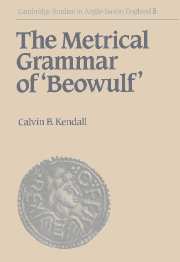Book contents
- Frontmatter
- Contents
- Preface
- List of abbreviations
- List of changes from Klaeber's text
- 1 The Beowulf-poet and his metrical grammar
- 2 The alliterative and metrical principles of Beowulf: Kuhn's ‘laws’ and the transformational rule
- 3 The three kinds of half-lines: extra-metrical alliteration and type A3
- 4 Displacement
- 5 Stressed proclitic adjectives: X-positions and the insertion rule
- 6 Problems with the identification of clause-non-initial half-lines: the proclitic onset
- 7 Half-lines with internal clause divisions: the transformational rule (revised)
- 8 The alliterative requirement of unstressed prefixes and the copulative conjunctions
- 9 The alliterative requirement of prepositions and the proclitic adverbs and instrumentals
- 10 The alliterative requirement of proclitic adjectives and pronouns: the alliterative rule of proclitics
- 11 Displaced and detached proclitics
- 12 The three classes of compounds: the alliterative requirement of class I compounds
- 13 The alliterative behaviour of class II compounds
- 14 The alliterative behaviour of class III compounds and simplexes
- 15 Metrical typology and the metrical grammar
- 16 Conclusions
- Appendix: A typology of the metre of Beowulf in relation to the metrical grammar
- Glossary of technical terms
- Bibliography
- Index of alliteration, scansion and metrical clause structure
- Index of verses specially discussed
16 - Conclusions
Published online by Cambridge University Press: 22 September 2009
- Frontmatter
- Contents
- Preface
- List of abbreviations
- List of changes from Klaeber's text
- 1 The Beowulf-poet and his metrical grammar
- 2 The alliterative and metrical principles of Beowulf: Kuhn's ‘laws’ and the transformational rule
- 3 The three kinds of half-lines: extra-metrical alliteration and type A3
- 4 Displacement
- 5 Stressed proclitic adjectives: X-positions and the insertion rule
- 6 Problems with the identification of clause-non-initial half-lines: the proclitic onset
- 7 Half-lines with internal clause divisions: the transformational rule (revised)
- 8 The alliterative requirement of unstressed prefixes and the copulative conjunctions
- 9 The alliterative requirement of prepositions and the proclitic adverbs and instrumentals
- 10 The alliterative requirement of proclitic adjectives and pronouns: the alliterative rule of proclitics
- 11 Displaced and detached proclitics
- 12 The three classes of compounds: the alliterative requirement of class I compounds
- 13 The alliterative behaviour of class II compounds
- 14 The alliterative behaviour of class III compounds and simplexes
- 15 Metrical typology and the metrical grammar
- 16 Conclusions
- Appendix: A typology of the metre of Beowulf in relation to the metrical grammar
- Glossary of technical terms
- Bibliography
- Index of alliteration, scansion and metrical clause structure
- Index of verses specially discussed
Summary
I began with the assumption that the half-lines of Beowulfare ‘formulaic’, not in the sense that any particular half-line must have been traditional or a variant of a traditional verse, though many of them are, but rather in the sense that the alliteration, the metre and the syntax of the half-lines are interrelated in precise and predictable ways which form recurring patterns. This study has both confirmed and given new precision to that assumption. The half-lines are formulaic because they are the product of the poet's metrical grammar. The Beowulf-poet did not impose metre or alliteration on a phrase he wished to use, nor did he distort or rearrange the phrase in order to secure a particular metrical contour or alliterative pattern. He composed with the half-lines which his metrical grammar provided (even if the half-line was entirely his creation), and which came already marked for metre and alliteration. The exercise of his genius came in his choice or creation of half-lines which conformed to his metrical grammar and the way he linked them together.
Whether art is conservative or iconoclastic, all artists inherit a tradition which they interpret and express in their individual manners. I do not want to leave the impression, which I may have given, that the metrical grammar was some kind of invisible book of unchanging rules which the Beowulf-poet received from the tradition and over which he had no control.
- Type
- Chapter
- Information
- The Metrical Grammar of Beowulf , pp. 206 - 218Publisher: Cambridge University PressPrint publication year: 1991



